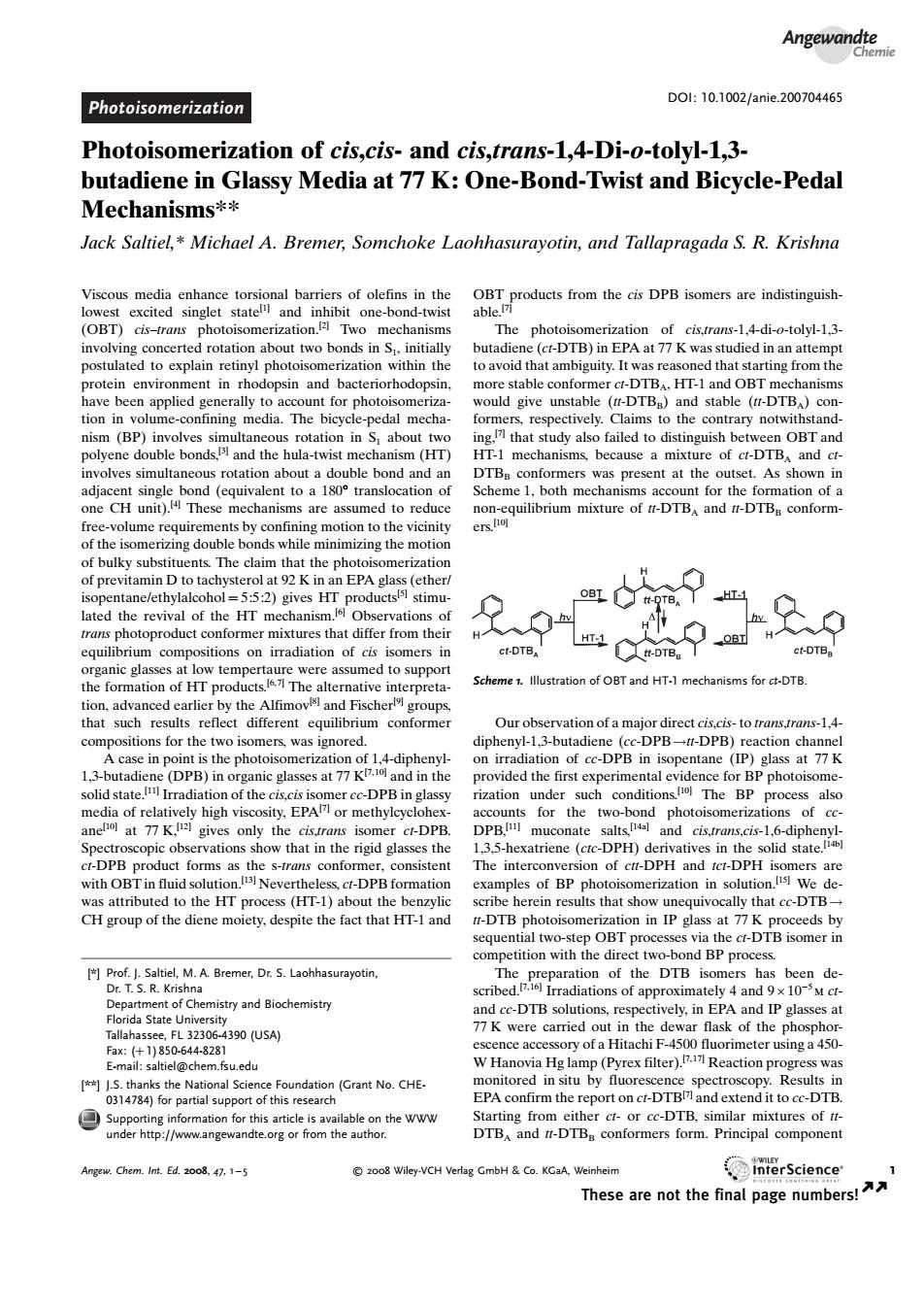正在加载图片...

Angewandte Photoisomerization D01:10.1002/anie.20070446 Photoisomerization of cis,cis-and cis,trans-1,4-Di-o-tolyl-1,3- butadiene in Glassy Media at 77 K:One-Bond-Twist and Bicycle-Pedal Mechanisms* Jack Saltiel,*Michael A.Bremer,Somchoke Laohhasurayotin,and Tallapragada S.R.Krishna lo BT) ciS-rans out two hon nretinyl photois applied ge for ph stable (#-DTBA)con (BP) e-confining medi in s failed t polyene dou le bondsandthehu-twist mec (HT hanisms,because a mixture of ct-DTB.and c scheme 1.both mchanis nt for the fo mation of a CH are GquibammitureofpTE,andDg,omo h 2)anis tran toproduct mixtures that difer from thei ct-DTB, H on formation of T prod Scheme 1.Illustration of OBT and HT-1 mechanisms for ct-DTB. The alter ative in Our vation of a majo s Ic (P)slass at 77K (DPB)in o organic glasses at 77K a of forthe two-bond photoisomeriz of co in the rig DPB product forms as thesr ns confor consisten omers are T proces()abou the benzy cribe herein that show unequivocally that c-TB CH group of the diene moiety.despite the fact that HT-1 and on in IP glass at7 compeonmihhcdreotondBPpOe M.ABe and Biochm a Sta 32306 390U5A y of a Hitac Aconfirm the report onc-TBandextentoDTB Chem.Int.Ed 2008 These are not the final page numbers! Photoisomerization DOI: 10.1002/anie.200704465 Photoisomerization of cis,cis- and cis,trans-1,4-Di-o-tolyl-1,3- butadiene in Glassy Media at 77 K: One-Bond-Twist and Bicycle-Pedal Mechanisms** Jack Saltiel,* Michael A. Bremer, Somchoke Laohhasurayotin, and Tallapragada S. R. Krishna Viscous media enhance torsional barriers of olefins in the lowest excited singlet state[1] and inhibit one-bond-twist (OBT) cis–trans photoisomerization.[2] Two mechanisms involving concerted rotation about two bonds in S1, initially postulated to explain retinyl photoisomerization within the protein environment in rhodopsin and bacteriorhodopsin, have been applied generally to account for photoisomerization in volume-confining media. The bicycle-pedal mechanism (BP) involves simultaneous rotation in S1 about two polyene double bonds,[3] and the hula-twist mechanism (HT) involves simultaneous rotation about a double bond and an adjacent single bond (equivalent to a 1808 translocation of one CH unit).[4] These mechanisms are assumed to reduce free-volume requirements by confining motion to the vicinity of the isomerizing double bonds while minimizing the motion of bulky substituents. The claim that the photoisomerization of previtamin D to tachysterol at 92 K in an EPA glass (ether/ isopentane/ethylalcohol = 5:5:2) gives HT products[5] stimulated the revival of the HT mechanism.[6] Observations of trans photoproduct conformer mixtures that differ from their equilibrium compositions on irradiation of cis isomers in organic glasses at low tempertaure were assumed to support the formation of HT products.[6, 7] The alternative interpretation, advanced earlier by the Alfimov[8] and Fischer[9] groups, that such results reflect different equilibrium conformer compositions for the two isomers, was ignored. A case in point is the photoisomerization of 1,4-diphenyl- 1,3-butadiene (DPB) in organic glasses at 77 K[7, 10] and in the solid state.[11] Irradiation of the cis,cis isomer cc-DPB in glassy media of relatively high viscosity, EPA[7] or methylcyclohexane[10] at 77 K,[12] gives only the cis,trans isomer ct-DPB. Spectroscopic observations show that in the rigid glasses the ct-DPB product forms as the s-trans conformer, consistent with OBT in fluid solution.[13] Nevertheless, ct-DPB formation was attributed to the HT process (HT-1) about the benzylic CH group of the diene moiety, despite the fact that HT-1 and OBT products from the cis DPB isomers are indistinguishable.[7] The photoisomerization of cis,trans-1,4-di-o-tolyl-1,3- butadiene (ct-DTB) in EPA at 77 K was studied in an attempt to avoid that ambiguity. It was reasoned that starting from the more stable conformer ct-DTBA, HT-1 and OBT mechanisms would give unstable (tt-DTBB) and stable (tt-DTBA) conformers, respectively. Claims to the contrary notwithstanding,[7] that study also failed to distinguish between OBT and HT-1 mechanisms, because a mixture of ct-DTBA and ctDTBB conformers was present at the outset. As shown in Scheme 1, both mechanisms account for the formation of a non-equilibrium mixture of tt-DTBA and tt-DTBB conformers.[10] Our observation of a major direct cis,cis- to trans,trans-1,4- diphenyl-1,3-butadiene (cc-DPB!tt-DPB) reaction channel on irradiation of cc-DPB in isopentane (IP) glass at 77 K provided the first experimental evidence for BP photoisomerization under such conditions.[10] The BP process also accounts for the two-bond photoisomerizations of ccDPB,[11] muconate salts,[14a] and cis,trans,cis-1,6-diphenyl- 1,3,5-hexatriene (ctc-DPH) derivatives in the solid state.[14b] The interconversion of ctt-DPH and tct-DPH isomers are examples of BP photoisomerization in solution.[15] We describe herein results that show unequivocally that cc-DTB! tt-DTB photoisomerization in IP glass at 77 K proceeds by sequential two-step OBT processes via the ct-DTB isomer in competition with the direct two-bond BP process. The preparation of the DTB isomers has been described.[7, 16] Irradiations of approximately 4 and 9 ? 105m ctand cc-DTB solutions, respectively, in EPA and IP glasses at 77 K were carried out in the dewar flask of the phosphorescence accessory of a Hitachi F-4500 fluorimeter using a 450- W Hanovia Hg lamp (Pyrex filter).[7, 17] Reaction progress was monitored in situ by fluorescence spectroscopy. Results in EPA confirm the report on ct-DTB[7] and extend it to cc-DTB. Starting from either ct- or cc-DTB, similar mixtures of ttDTBA and tt-DTBB conformers form. Principal component Scheme 1. Illustration of OBT and HT-1 mechanisms for ct-DTB. [*] Prof. J. Saltiel, M. A. Bremer, Dr. S. Laohhasurayotin, Dr. T. S. R. Krishna Department of Chemistry and Biochemistry Florida State University Tallahassee, FL 32306-4390 (USA) Fax: (+1) 850-644-8281 E-mail: saltiel@chem.fsu.edu [**] J.S. thanks the National Science Foundation (Grant No. CHE- 0314784) for partial support of this research Supporting information for this article is available on the WWW under http://www.angewandte.org or from the author. Angewandte Chemie Angew. Chem. Int. Ed. 2008, 47, 1 – 5 2008 Wiley-VCH Verlag GmbH & Co. KGaA, Weinheim 1 These are not the final page numbers! �